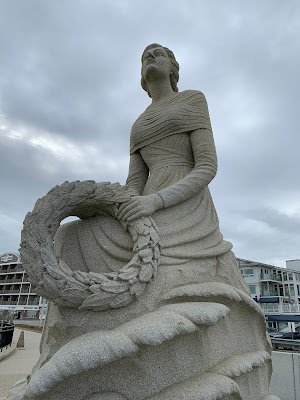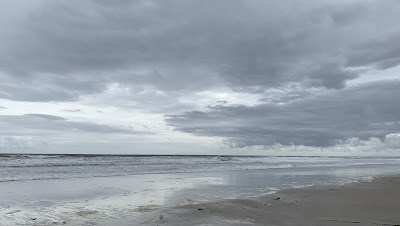Even though I have lived in New Hampshire for upwards of forty years, I have only visited Hampton Beach three times. The first of these occasions took place many years a go on a bitter cold winter day. It was a very short visit, and I scarcely remember it. The second visit, with two grandchildren, took place on a beautiful summer day two years ago. I remember this one very well. The grandchildren were fascinated by both the Atlantic Ocean and the marine biology exhibits at the adjacent Blue Ocean Discovery Center. The third, without the grandchildren, took place just recently, on Wednesday, September 25, 2024. This one was quite different and more serious.
Long
and wide sandy beaches are rare in northern New England, and so Hampton Beach
becomes extremely crowded on hot summer days.
For this reason, we always avoided it in favor of less crowded
facilities in nearby Maine. Besides, the
Maine beaches were closer to Miss Patty’s parents’ house. But we thought Hampton Beach would likely not
be crowded on a September weekday, and so we seized the opportunity. As always, it felt wonderful to gaze upon the
great Atlantic, scan the horizon, feel the breeze, and watch and listen to the
surf. It was also very pleasant to stroll
along the promenade that parallels the beach.
Several attractive pavilions for public accommodation and park
administration dot this promenade, and at its northern end stands the New
Hampshire Marine Memorial. I had never
seen or heard of this before, and so I felt drawn to it.
The
memorial features a statue of a young lady facing seaward and holding a wreath
in honor of the New Hampshire residents who served in the armed forces and were
lost at sea. Around the upper base of
the memorial, two verses of poetry are inscribed in large letters:
Breathe
soft, ye winds,
Ye waves in silence rest.[1]
Beneath
this, on the lower base of the monument, is further inscribed:
In memory of New Hampshire’s heroic war dead
Lost at sea in defense of our country.
Following
this and occupying a large part of the lower base is an alphabetical list of
approximately 240 names of servicemen, with their branches of the service
indicated. The vast majority were Navy men. Several were Marines or Coast Guardsmen. A few were Army or Air Force.
Seeing
and studying the New Hampshire Marine Memorial for the first time was a moving
experience for me. I had not expected to
discover this during a leisurely and carefree day at the oceanfront. But there it was, and it commanded my
attention. While I naturally regretted
the loss of life that it represented, I was pleased that these seamen were
remembered and that their sacrifices were publicly acknowledged. I also wondered how many beachgoers on a hot
summer day paused to look at this monument and contemplate its significance.
My
only reservation was that the list of names did not include the many merchant
seamen who perished at sea in wartime.
In the 1940s, the Merchant Marine was incorporated into a federal
organization titled the United States Maritime Service, or USMS. The seamen who manned the cargo ships, oil
tankers, and troop transports suffered a casualty rate exceeded, on a
percentage basis, only by the Marine Corps.
While monuments to their
sacrifices do exist, they tend to be not very well known by the general public.
Nonetheless,
I was pleased to come upon this monument to our state’s military personnel who
tragically lost their lives at sea. It
left me with little to say but much to consider. Fortunately, it was an uncrowded, off-season day
at the beach, which created an atmosphere suitable for quiet contemplation. I appreciated that very much.
Now,
I’m pleased to share some photographs. First, we see the full monument. The young lady portrayed, flanked by the New
Hampshire state flag, faces east toward the sea. The building in the rear is a hotel:
Next, we have three close-up views of the young lady. The facial expression, combined with the background of dark cumulus clouds, seems to convey a sense of foreboding:
Finally,
we look southeastward over the surf and beyond to the horizon of the great
Atlantic Ocean. Despite the ominous
appearance of the low-hanging cloud cover, it really was a magnificent day at
the waterfront:
[1] Lines from John
Gay (1685-1732), “Epistle to a Lady,” 1714.
Information from https://www.seacoastnh.com/places-%26-events/nh-history/hampton-beach/sculpture-by-the-sea.





I am certain that hardly any beachgoers stop to actually read this monument, so thank you for filling us in. I am digging all the gray tones in your photos!
ReplyDeleteI have learned to appreciate these monuments much more as I have grown older, and just the pictures and poetry from this one touch me deeply. Always it is the women who have watched and waited for their men to come home from whatever danger they have gone off to face, and this sculpture captures that feeling exceptionally well.
ReplyDelete